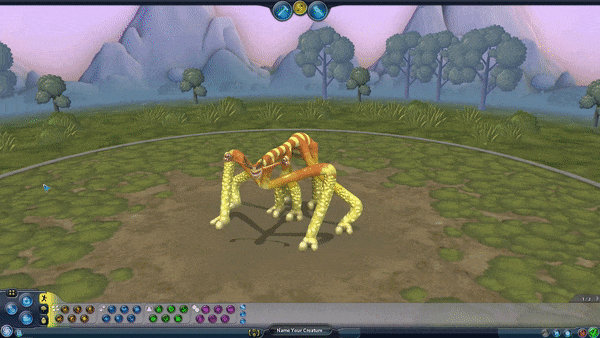Spore was a game sufficiently anticipated that its release received mainstream media coverage. Legendary game designer Will Wright was going to follow up his mega hit SimCity and The Sims games with a title that would simulate evolution across a whole galaxy. It was to be the apotheosis of gaming. With such high expectations, it was almost inevitable that the game would fall short. A troubled development, including resistance from creationists within the development team to making a game that depicted evolution, and publisher EA insisting that the game be monetisable in a similar way to cash cow The Sims led to a game that was ultimately too compromised to truly succeed. Despite its failings, I keep coming back to Spore, every time hopeful that it will somehow be different.
The basic premise was that you would guide a species through a series of developmental stages, each with unique visual styles and gameplay, eventually reaching the point of being an interstellar civilisation. Unfortunately each stage of the game tends to feel a little underdeveloped. It’s clear that the intention was that should work as stand alone games in their own right, but usually they’re too simple to be genuinely compelling.
The stage that comes closest is the “Civilization Stage”, which sees you trying to unite the planet under a single government. It essentially plays like a simple RTS game, you design city layouts and send custom vehicles to conquer neighboring cities. The stage was designed by Soren Johnson, lead designer of Sid Meier's Civilization IV, and plays reasonably well, if it is a little too simplistic to want to spend much time with.
The meat of the game is the “Space Stage”, a galactic sandbox that lets you build a space empire while exploring and observing other worlds going through the stages you just played through. At the time Spore presented something that felt almost unfathomable. The scale of the galaxy you were presented with felt simultaneously vast and detailed. Every star and planet could be visited, and many of them would be inhabited by alien species. Spore launched with an emphasis on players sharing their creations through an inbuilt online tool, and theoretically every world could be uniquely populated through a near infinite library of community designed species. While the reality never quite lived up to the hype, it did still convey a sense of scale unlike anything else available at the time.
Of course, what Spore does now feels less unique. In the years since its release a number of space sandbox games featuring full scale galaxies have released, and one of those, Hello Games’ No Man’s Sky, features a similar system of kit-set species to populate its colourful worlds (albeit algorithmically driven rather than relying on player and developer creations).
Spore manages to pull off its fully traversable galaxy with surprisingly few seams or technical hitches. It’s easy to leap from world to world, and what small loading screens do exist are effectively concealed with transitory effects. Where Spore’s galactic exploration exceeds its successors is in your ability to leave a lasting impact. You possess a variety of tools with which you can sculpt the planets you encounter. Some of these are practical, allowing you to terraform and colonise new worlds for you space empire, while others are aesthetic, allowing you to customise the appearance of or planets in surprisingly granular fashion.
So much of the technology underpinning the game still feels magical to this day, especially the creature creator tools. The fact that you can design almost any configuration of limbs and body parts and the game figures out how to animate it is still an astonishing technical feat today. Of course, the intuitive power of the creature creator only serve to emphasise how frustrating the other creative tools are. The vehicle and building editors are regularly exercises in frustration, and rarely lead to results that look as good as the creatures do. It’s a particular frustration, as once you reach the stage of creating space colonies the game expects you to interact with the building creator a lot, and does little to streamline the process of avoiding it when you start to tire of plopping buildings on generic space-cities.
I wish I could offer a pithy lesson that can be learned from Spore’s failure, but I don’t think I can. Spore did so much right, but was stymied more by external factors that its own flaws. It’s difficult to recommend Spore as a game, it’s too likely to disappoint. For my money, Paradox Studios’ Stellaris picks up and runs with the best ideas from Spore. That game gives you ample scope to explore and play with a dynamic and interesting galaxy, but with a little more meat on its bones. Spore’s technology remains a fun toy to engage with at a surface level, and perhaps that is the way it is best approached in retrospect, as an elaborate toy rather than a compelling, structured experience.







